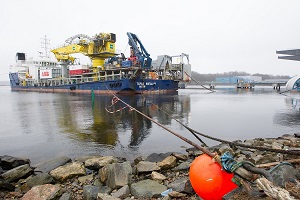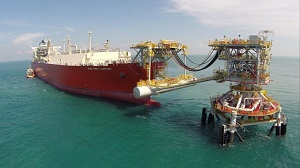Russia and Lithuania in Power Link Tussle
The Russian navy has been accused of deliberately disrupting the construction of an undersea power cable between Lithuania and Sweden.
The NordBalt cable, designed by ABB, will be the world’s longest high voltage direct current extruded cable. Once operational it is expected to significantly reduce Lithuania’s reliance on Russia for energy.
 Lithuania claims that a Russian navy vessel has entered its waters four times over the last month, forcing the cable laying ship to change course. The nation has summoned its Russian ambassador to lodge a formal protest, but says it was not provided with any explanation of the navy’s behavior.
Lithuania claims that a Russian navy vessel has entered its waters four times over the last month, forcing the cable laying ship to change course. The nation has summoned its Russian ambassador to lodge a formal protest, but says it was not provided with any explanation of the navy’s behavior.
Meanwhile Lithuanian media reports that a Russian naval commander says the area has been chosen for military exercises.
Sweden has backed Lithuania over what its foreign ministry calls unacceptable behavior by the Russian navy, the Financial Times reports.
The cable will run 400km (250 miles) from Lithuania to Sweden, and the cable-laying vessel Topaz Installer is currently laying two high voltage direct current cables, each 50 km long, and a fiber optic cable for long-distance data exchange. Cable laying commenced in April 2014 and is expected to be completed later this year.
The ship has been chased away from its work in separate incidents on 29 March, 10 April, 24 April and now 30 April, reports The Independent.
In March, a Russian defense official said that the region will shortly be equipped with Iskander missiles. These ballistic weapons could reportedly reach as far as Berlin.
.jpg) According to the statement issued by the Association for Prevention of War Legacy Threats, the discovery of artillery shells, mines and grenades, possibly from World War II, have also hampered the laying of the submarine power link.
According to the statement issued by the Association for Prevention of War Legacy Threats, the discovery of artillery shells, mines and grenades, possibly from World War II, have also hampered the laying of the submarine power link.
Once operational, the link will help to strengthen the security of the power supply in Lithuania and integrate an emerging joint Baltic electricity market with the Nordic and European markets. The link is designed for integration into a future pan-European grid with the evolution of a DC grid concept under discussion around the world.
Lithuania Looks to the U.S.
Lithuanian LNG importer Litgas signed a preliminary agreement with a U.S. supplier earlier this year, looking again to lessen its energy dependence on Russia. Litgas signed a memorandum of understanding (MOU) with Delfin LNG, a developer of the United States' first offshore gas liquefaction project.
Delfin LNG is developing an offshore liquefaction and export facility in Louisiana with a total export capacity of 13 million tons of LNG per year (about 18 billion cubic meters of natural gas). Subject to regulatory approval, the project will be constructed in phases, and is expected to start in 2019.
Greater Independence
Lithuania has already achieved a greater degree of energy independence with a new LNG import terminal opened in Klaipeda last year. Klaipedos Nafter has chartered the FSRU Independence from Höegh LNG for use as an LNG import terminal.
 The terminal has a total import capacity of 4 bcm of natural gas (2.9 million tons of LNG) compared with annual consumption in the Baltic states of 4-5 bcm.
The terminal has a total import capacity of 4 bcm of natural gas (2.9 million tons of LNG) compared with annual consumption in the Baltic states of 4-5 bcm.
Last year, Litgas signed a five-year contract to buy 0.54 billion cubic meters of natural gas per year from Norway's Statoil and received the first commercial LNG cargo at the end of December via the FSRU.
Since the terminal opened, Russia’s Gazprom has cut the price of gas supplies to Lithuania by 20 percent.
Lithuania is now considering allowing the terminal to re-export LNG to global markets during summer when local demand declines.
Building Defenses
Lithuania, spooked by Russian military assertiveness, outlined plans earlier this year to raise defense spending by a third in 2016, contributing the highest share of its economy to defense since it joined NATO in 2004.
Lithuania has already upped defense spending in 2014 and 2015, and its political parties have promised to reach the two percent of GDP goal set by NATO no later than in 2020.
"This will get our army to a whole new level, it will be ready to ensure defense and deterrence, both in its own right and together with the allies," Defense Minister Juozas Olekas told reporters at the time.
The minister did not mention Russia by name, but Lithuania's leaders have frequently referred to the threat from its huge non-NATO neighbor and former Soviet ruler.
Lithuania has warily watched Russian military drills in the Kaliningrad enclave, which borders the country. A drill in December 2014 mobilized 9,000 soldiers and 55 naval ships to Kaliningrad.
A World Record
The NordBalt transmission system operator in Sweden is Svenska Kraftnät and in Lithuania is Litgrid turtas. The 700 MW ±300 kV transmission line is the world’s longest HVDC Light underground and subsea cable.
 HVDC Light transmission will increase capacity, facilitate power exchange, enhance grid reliability and improve the security of electricity supply at either end. The system incorporates special features such as active AC voltage support providing greater network stability and black-start capability providing faster grid restoration after a blackout.
HVDC Light transmission will increase capacity, facilitate power exchange, enhance grid reliability and improve the security of electricity supply at either end. The system incorporates special features such as active AC voltage support providing greater network stability and black-start capability providing faster grid restoration after a blackout.
In the last 150km currently being laid the NordBalt cable will cross the NordStream gas pipeline. At the crossover point a special protective layer will be built over the pipeline and then the cable will be laid on top of this.
To protect the cable against the damage caused by fishing equipment and anchors, water jet trenching is used to bury the cable one meter into the seabed. In places where the seabed is rocky, the cable is protected by rock dumping.
